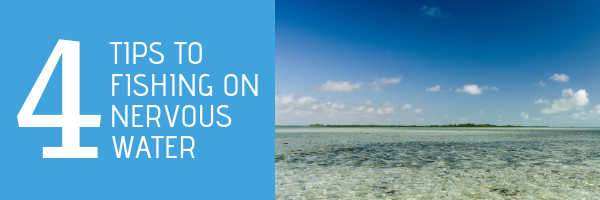One of the biggest challenges in catching bonefish is learning how to spot them.
Not only are these fish known for being stealthy and exceedingly good at avoiding capture, but they’re also blessed with mirror-like scales that perfectly reflect their surrounding environment. When these fish turn sideways, it can be difficult to distinguish them from the flat bottom. Fortunately, nervous water or water that’s being agitated as the result of movement, can make it infinitely easier to spot your target. Following are four tips to fishing on nervous water that will make you next adventure more than worthwhile.
1. Target The Fish
Dimples, splashes and wakes are the surface disturbances that define nervous water. They mean that one or more fish is displacing water volume in a specific area by moving about. When lots of bones are present, this normally subtle activity becomes quite obvious. Depending upon the type of movement that you’re seeing, you might want to cast slightly beyond your target in order to land the fly right where the fish can see it. When nervous water is the result of tailing, however, you should target the fish directly instead. Tailing fish are usually creating small plumes of mud at the flat bottom as they sift and search for food. Their tails will be visible outside of the water, and casting to your prey will be all too easy.
2. Cast Forward
Cast forward to minimize the likelihood of accidentally casting beyond the bone that you’re targeting. Casting behind a feeding bone will usually cause the target to flee. Surprisingly, many inexperienced fishers have been able to land bones on their very first trips with simple, forward casts, good timing, and good direction from their guides. When you spot nervous water, wait for direction before setting your cast up. Given their experience on the flats, most guides are able to pinpoint the exact location of bones even when nervous waters are muddy and the reflective scales of bonefish have made them nearly impossible for others to see.
3. Keep An Eye On The Direction Of The Fish
Pay attention to the direction that fish are moving in. Tailing bonefish are the ideal targets given that they’ll likely be in one place long enough for you to both set your cast up and deliver it. However, tailing is not the sole source of nervous waters. These fish might be foraging for food at the flat bottom or simply cruising along. When their reflective scales make them difficult to spot, check for their shadows instead. While you might not be able to see the fish themselves, their shadows can alert you to their location and their direction. If casting for moving fish, try to land your fly approximately three to 10 feet ahead of your target or just off to the side of this. Ultimately, you want your fly to be both visible and convincing.
4. Don’t Just Look – Listen
What your eyes can’t see and your guide can’t tell you can usually be obtained by using your ears. There are definitely a number of audible signs that bonefish are on the move in the area. In addition to looking for mud plumes at the flat bottom and sharp tails jutting out from the surface of the water, you should also listen for the distinct sounds that nervous water and tailing bones invariably create.









